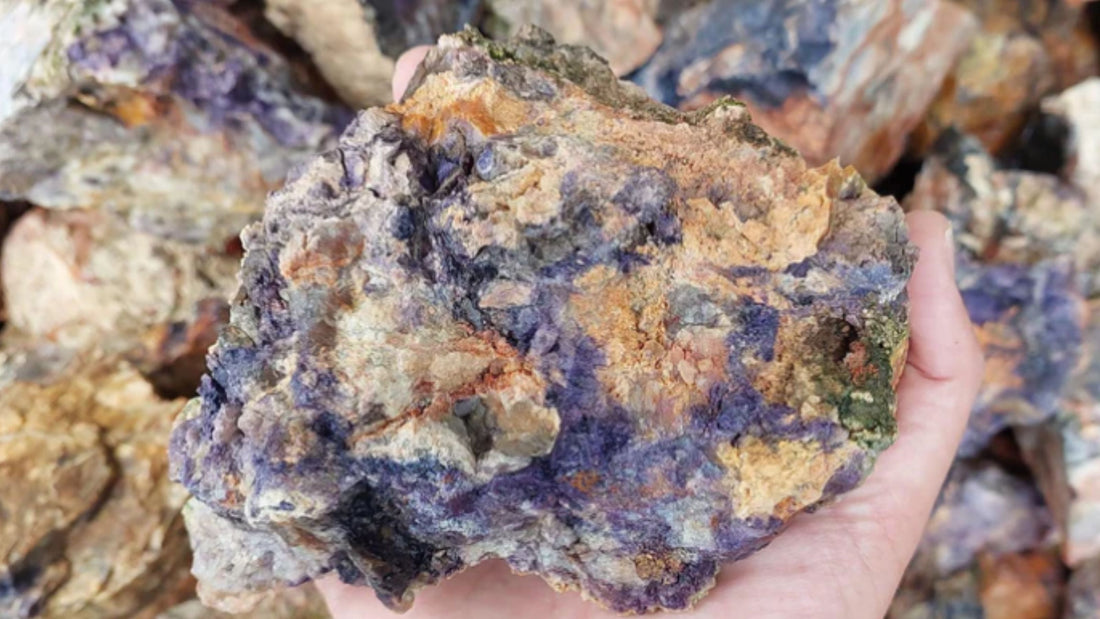Tiffany Stone, also known as Bertrandite, is a rare and colourful gemstone found exclusively at the Brush Wellman beryllium mine in Spor Mountain, Utah. This unique gemstone is composed of a mix of minerals, including opalised fluorite, chalcedony, and bertrandite, which give it its striking appearance.
It is not a single mineral but rather a rock composed of several minerals and substances. The stone is named after the famous jewellery company Tiffany & Co., due to its resemblance to beautiful stained glass.
Geological Formation
Tiffany Stone is primarily composed of bertrandite, a mineral that contains beryllium. The formation of bertrandite-rich deposits begins with the circulation of hydrothermal fluids carrying dissolved beryllium. These fluids are typically hot and contain various dissolved minerals. As the hydrothermal fluids move through fractures and cavities in the surrounding rocks, they encounter conditions where the temperature and pressure change, causing the dissolved minerals, including bertrandite, to precipitate and form solid mineral deposits. The presence of other minerals such as fluorite, opal, calcite, and chalcedony contributes to the stone's striking colours and patterns.
Physical and Optical Properties
Tiffany Stone is known for its vivid and diverse colours, which can range from lavender and purple to pink, blue, and even white. The stone often exhibits a swirling pattern of colours, making it highly prized by collectors and lapidary enthusiasts. It is also fluorescent under UV light due to its fluorite and opal content, displaying a mossy green pattern of fluorescence.
Due to its unique appearance, Tiffany Stone is often cut and polished to create striking cabochons for use in jewellery. It is also used in decorative items and as a collector's gemstone. The stone's rarity and beauty make it a sought-after material in the world of gemstones.
Notable Locations
The only known source of Tiffany Stone is the Brush Wellman beryllium mine at Spor Mountain, near Delta, Utah. The Brush Wellman beryllium mine at Spor Mountain, near Delta, Utah, is an excellent location for Tiffany Stone (bertrandite) for several reasons:
Geological Conditions
-
Hydrothermal Activity: Spor Mountain has a history of significant hydrothermal activity, which is essential for the formation of bertrandite-rich deposits. Hot, mineral-laden fluids circulated through the rocks, leading to the precipitation of minerals like bertrandite.
-
Unique Mineral Composition: The area is rich in minerals like fluorite, opal, calcite, and chalcedony, which contribute to the unique and vibrant colours of Tiffany Stone. These minerals form concentric layers around the bertrandite, creating the characteristic orbicular patterns.
-
Carbonate Clasts: The nodules of Tiffany Stone are typically carbonate clasts that have undergone mineral replacement processes. These clasts, originally composed of carbonate minerals, have been largely replaced by fluorite, with small amounts of bertrandite present as submicroscopic grains, giving the stone its distinctive appearance.
Location and Access
-
Concentration of Resources: The Brush Wellman mine is one of the few places in the world where these specific geological conditions come together to produce Tiffany Stone. This concentration of resources makes it a unique and valuable location.
-
Mining Infrastructure: The presence of an established mining operation ensures that the extraction and processing of Tiffany Stone can be done efficiently. The mine is equipped with the necessary infrastructure to handle the complex process of extracting and refining beryllium and associated minerals.
-
Accessibility: Being situated near Delta, Utah, the mine is relatively accessible, allowing for the transportation of the extracted stone to various markets, both domestically and internationally.
Economic and Scientific Importance
-
Economic Value: Tiffany Stone is highly prized for its aesthetic appeal and rarity, making it a valuable commodity in the gemstone market. The Brush Wellman mine capitalises on this value by producing and supplying Tiffany Stone for jewellery and decorative purposes.
-
Scientific Interest: The unique formation processes and mineral composition of Tiffany Stone make it a subject of scientific study. Geologists and mineralogists are interested in understanding the conditions that lead to the formation of such rare and beautiful stones, providing insights into Earth's geological history.
Conclusion
Tiffany Stone is a fascinating gemstone with a unique combination of minerals that give it its striking appearance. Its rarity and beauty make it a valuable addition to any collection, and its geological formation provides insight into the complex processes that create such rare and beautiful stones.
References
-
Geology Science:
-
:
-
Nature's Rainbows:

